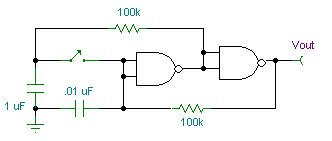Here's a circuit which implements a radio button arrangement.
All switches activate the clock.
One of the switches enables a latch which has no output connection.
The other two switches each enable an output.
If neither of those outputs are enabled a DTL NOR gate creates a logic high indicating that neither switch if 'on'.
So switch one and two operate as radio buttons (mutually exclusive) and the reset switch disables the other two outputs.
If sw1 is active, and I push the button again nothing happens, sw1 remains active. I can only disable sw1 and sw2 by pressing the reset switch.
I don't want this.
It occurs to me that the reset switch COULD be made redundant. What I really need is for each switch to toggle itself on and off, and IF it toggles high to disable the other switch.
ie. (truth table)
S1 S2 S1_CURR S2_CURR S1_NEW S2_NEW
1 0 0 0 1 0
1 0 1 0 0 0
0 1 0 0 0 1
0 1 0 1 0 0
1 0 0 1 1 0
0 1 1 0 0 1
etc.
KEY
S? = status of switch 1 (1 = closed, 0 = open)
S?_CURR = status of current latch output for the given switch (1=high, 0=low)
S?_NEW = the result of the switch press
I could have one of these on each button :
But how would I link two of these together in a radio button arrangement (mutually exclusive).
I considered some sort of XOR arrangement but that has issues.
I think this may be a pretty standard requirement that someone might know the solution to?
Many thanks for anyone who can be bothered to read this!



